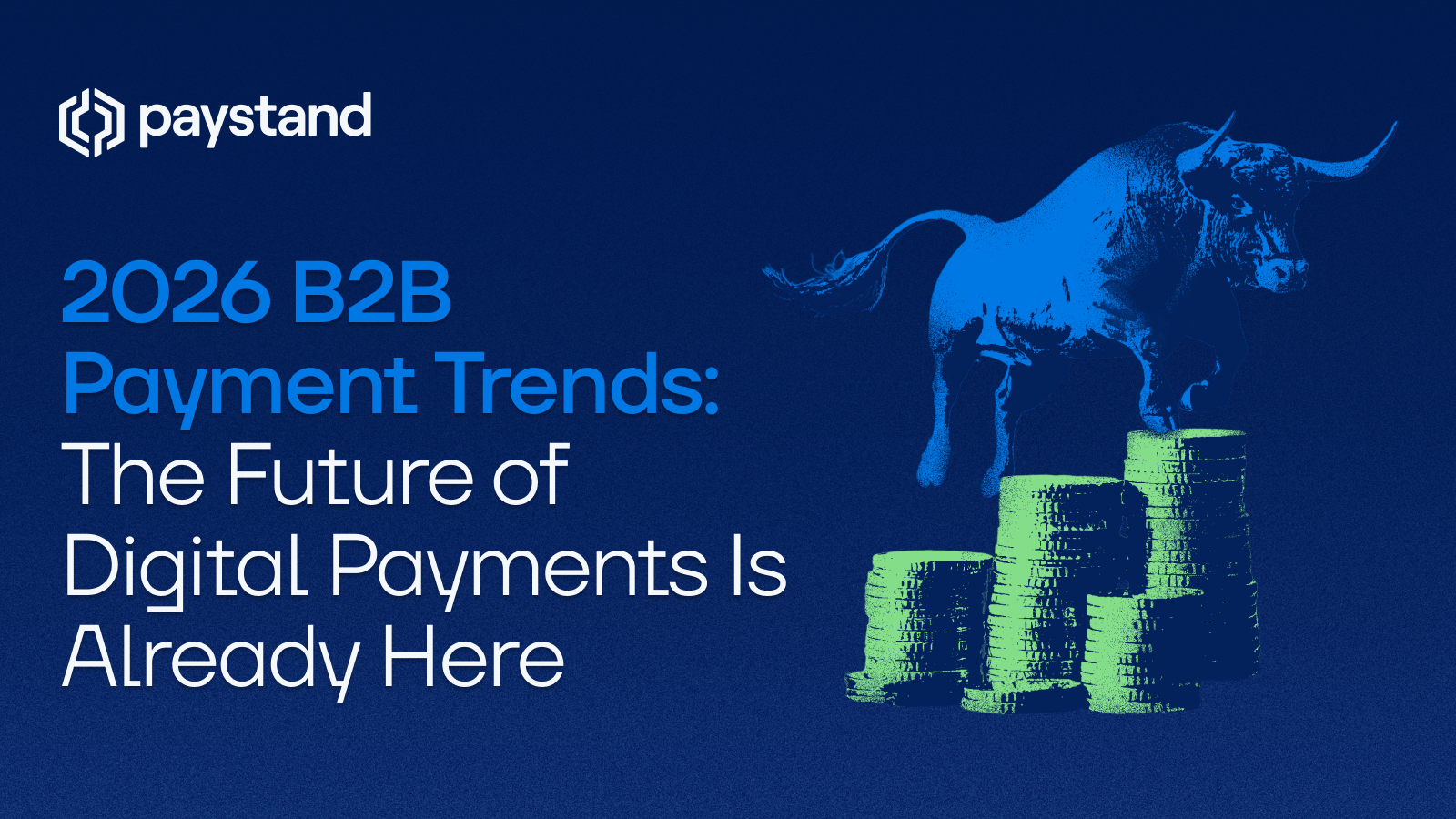2026 B2B Payment Trends: The Future of Digital Payments Is Already Here

Table of Contents
- The Future of Digital Payment in the Next 5 Years
- B2B E-commerce Payment Trends
- The Latest Trends in Online Payment Systems
- Recent Trends in B2B Payments Made via Check
- How AI and Automation Are Transforming Finance
- The Role of Real-Time and ACH Payments in Faster Cash Flow
- Cross-Border Payments, Virtual Cards, and Fraud Prevention
- Why It’s Time to Rethink Traditional Payment Methods
- What Finance Leaders Can Do to Stay Ahead of the Curve
Key Takeaways
- Digital payments are now the backbone of B2B transactions, with electronic and real-time payments reducing processing times from days to seconds.
- AI-powered automation is revolutionizing accounts payable, reconciliation, and fraud detection—transforming finance teams into strategic partners.
- Virtual cards and ACH payments continue to replace traditional payment methods as businesses push for faster, safer, and more transparent cash flow.
- As cross-border transactions grow, CFOs are turning to unified payment platforms that simplify currency conversion and compliance.
- The organizations that stay ahead of the curve in automation, fraud prevention, and digitization will shape the future of B2B payments.
What Will Be the Future of Digital Payment in 5 Years?
The next five years will mark the end of manual, paper-based finance. The future of digital payment is built on automation, AI, and global interoperability.
Enterprises are replacing legacy workflows with zero-touch payments, where invoices move seamlessly from creation to settlement without manual review.
Companies using B2B invoicing automation and integrated AR tools already see up to 80% reductions in payment cycle times. These digital-first systems also strengthen fraud prevention by verifying every transaction in real time—something no paper process can match.
By 2030, the majority of global B2B transactions will occur through digital networks that combine instant settlement, AI decisioning, and cross-border payments capabilities.
B2B E-commerce Payment Trends
The rise of B2B ecommerce is reshaping how companies pay and get paid. Buyers expect the same frictionless experience they enjoy in consumer marketplaces—quick checkout, multiple payment options, and automated receipts.
In 2026, the top B2B ecommerce payment trends include:
- Virtual cards for flexible, secure supplier payments.
- Embedded real-time payment options inside procurement platforms.
- The expansion of digital cross-border transactions that reduce FX risk.
- Use of AI to detect anomalies and prevent payment fraud.
Forward-thinking organizations are integrating these capabilities directly into their ERPs through solutions like zero-touch payments, removing friction and manual review from every stage of the payment lifecycle.
What Are the Latest Trends in Online Payment Systems?
Online payment platforms have evolved far beyond credit card processing. Businesses are prioritizing tools that reduce fees, accelerate cash flow, and prevent fraud across both domestic and international payments.
The latest digital payment trends include:
- Consolidation of ACH payments and real-time payments into unified systems
- Built-in AI fraud prevention models that flag suspicious behavior
- Integration between AR automation and electronic payments for one-click settlement
- Growth in fee-free networks, where companies eliminate credit card costs altogether
Companies using zero-fee processing report major cost savings and fewer reconciliation errors, freeing up finance teams for higher-value work.
What Are the Recent Trends in B2B Payments Made via Check?
Despite digitization, check payments persist in certain industries—but their days are numbered. According to the 2025 AFP Payments Fraud and Control Survey, checks remain the leading source of payment fraud, accounting for over 60% of incidents.
Businesses are rapidly phasing them out in favor of secure, electronic payments like ACH and real-time payments, which drastically reduce fraud exposure. Many are also using advance payments and recurring billing automation to accelerate collections and improve liquidity.
Companies leveraging advanced payment automation now settle invoices days or even weeks faster than those relying on paper checks.
How AI and Automation Are Transforming Finance
The next evolution in accounts payable and AR isn’t human—it’s algorithmic. Artificial intelligence (AI) is changing how finance teams identify errors, predict cash flow, and mitigate fraud.
AI-powered systems can instantly match invoices, detect duplicates, and assess payment risk across cross-border payments. Combined with blockchain-backed audit trails, they offer unprecedented transparency and trust.
Finance leaders implementing automation through platforms like B2B payments integration report not just speed but control—reducing both human error and the risk of fraud.
The Role of Real-Time and ACH Payments in Faster Cash Flow
Real-time payments are redefining “on-time.” Businesses no longer need to wait days for settlement—ACH payments and instant transfers are streamlining reconciliation and reducing DSO dramatically.
Solutions like Paystand’s network-enabled infrastructure make it easy to integrate instant transfers into your AR workflows. As outlined in our benefits of real-time payments guide, companies that switch to automated rails gain faster access to cash, fewer exceptions, and improved visibility across systems.
Cross-Border Payments, Virtual Cards, and Fraud Prevention
Global trade is pushing companies to rethink how they handle cross-border transactions. With currency volatility and regional regulations complicating settlement, automation and virtual cards are becoming essential tools.
Virtual cards enable dynamic control and spending limits for suppliers worldwide, while AI-driven analytics strengthen fraud prevention by flagging anomalies before money moves.
In tandem, digital payments infrastructure ensures global compliance and consistent user experience, whether the transaction happens in CAD, USD, or EUR.
Why It’s Time to Rethink Traditional Payment Methods
Traditional payment methods like checks and wires were built for an era of slower commerce. Today’s pace demands flexibility, transparency, and speed.
Modern payment platforms combine AI, blockchain, and embedded ERP integrations to deliver zero-fee, real-time, and automated capabilities.
By reimagining payments as a connected system rather than a standalone step, finance teams can unlock greater cash visibility, eliminate manual work, and reduce costs—while improving fraud prevention across the board.
What Finance Leaders Can Do to Stay Ahead of the Curve
- Automate accounts payable and receivable to eliminate manual bottlenecks.
- Migrate from checks and wires to real-time and ACH payments.
- Deploy AI and fraud analytics to protect every transaction.
- Consolidate payment platforms to handle multi-currency and cross-border activity.
- Implement digital payments and zero-fee models to optimize profitability.
The future of B2B payments belongs to organizations that embrace automation, trust networks, and AI-powered efficiency. Those who modernize now will not only cut costs but truly stay ahead of the curve.
Download the 2026 B2B Payment Trends eBook
Want deeper insights and expert predictions on the technologies shaping the next five years of finance?
Download the B2B Payment Trends 2026 eBook to see how leading CFOs are preparing for the future of digital payments.







%20(1)%20(1).jpg?width=100&height=100&name=IMG_3752%20(1)%20(1)%20(1).jpg)